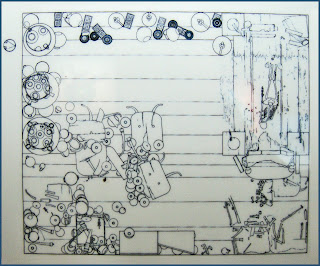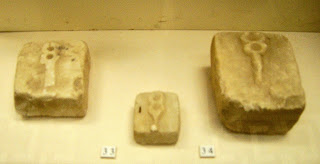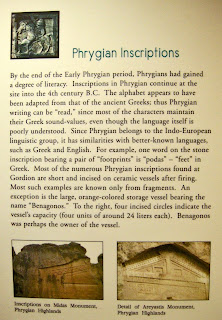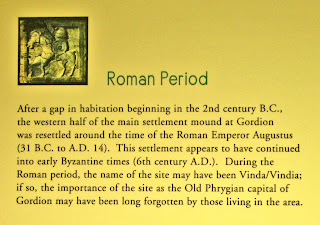Photos by Jack A. Waldron
The 'Great Tumulus', aka 'Midas Mound' (39°39'14.3"N 31°59'52.4"E), is the second largest Tumulus of the ancient world with a diameter of 300 meters; the largest tumulus thus far having been discovered being the Amphipolis Tumulus in Central Macedonia, Northern Greece, which has a diameter of 497 meters. Pictured above, the entrance to the Midas Mound. The 82 meter-long tunnel that leads to the tomb was dug by coal miners from Zonguldak (pictured below).
I am often fortunate to be the sole visitor at many of the sites I go to, and though the Great Tumulus is on the itinerary of large tour companies, the current climate and a weekday visit almost always ensures the peaceful tranquility these monuments can offer. It's similar to the range of temperature one experiences when walking through this tunnel, from 35 degrees outside, to around 15 degrees at the chamber.
The logs comprising the outside of the tomb are Juniperus Excels, aka Greek Juniper or Persian Juniper, and of these logs, some have rings indicating ages of nearly 2000 years. The ancients' knowledge of the medicinal qualities of this species, its herbal and culinary uses, its wood strength, and its inclusion in ancient ceremony is not lost on the possible reasons for its use here as a building material.
With the support filler removed from the space between the juniper log chamber walls and the stone wall surrounding the chamber, a support structure has been built around the chamber to preserve its integrity (pictured above and below).
Tension lines crisscross each other in a complex engineered cradle or girdle, which encapsulates the entire structure from top to bottom.
Pictured above and below, sections of the upper part of the chamber walls and roof with the support structure and tension lines at work.
The tomb dates from the 8C BC, and roughly falls within the timeline prior to the period of the Cimmerian invasion, which may shed light on its construction, perhaps for King Gordias, who ruled the kingdom before King Midas.
Pictured above, a closeup of the juniper logs, the material from which the outer wall of the chamber is constructed. Peering into the passageway to the inner chamber we can see a second wall, or lining to the chamber; this inner paneling is made from pine.
The human remains found in the chamber belonged to a man aged approximately sixty years old. He was lowered into the chamber from the top prior to the chamber being capped by a series of juniper logs. The passageway pictured below was created by the excavators in 1957.
With the remnants removed and the dust collected and analyzed, we can see how well the cold climate and lack of oxygen have preserved the wood.
This preservation was extended to the wood objects found amongst the treasure, including an inlaid wood table now on display in the Gordian Museum (pictured below).
The contents of the Midas Mound Tumulus had remained undisturbed until its excavation in 1957, and among the contents inside was the funerary meal prepared and set in place within the burial chamber.
According the chemical analysis done, the drink was a mixture of wine, beer and honey, while the meal was a stew of spicy red meat with lentils.
The bronze bowl illustrated above was one of the items found in the Midas Mound Tumulus. It features a Phrygian inscription on the rim, and is dated to 740 BC. Unfortunately, the bowl was not on display at the Gordian Museum. I will search for it at the Anatolia Civilizations Museum in Ankara.
It may be helpful to give a basic rundown of some historical periods in order to more easily put into perspective the objects found in and around the ancient city of Gordian. The early, middle and late bronze age spanned roughly from 3000 BC to 1200 BC. The early Phrygian period falls between 1100 BC and 800 BC. The middle to late Phrygian periods from 800 BC to the arrival of Alexander the Great in the 334 BC, when the Hellenistic period begins, followed by the Roman period from the 1C BC to the 5C BC.
Objects found around the area range from the prehistoric onwards, from the earliest settlements including the Hattians from the early bronze age.
Pictured below, ornamental boar tusks. These animals are still hunted in Turkey today, though not for their meat. They come out in the late evening and are so numerous that fake shotgun blasts can be heard around most farming communities in order to keep the animals away from the crops; I have personally been awoken by their alarming snorts in the darkness around my tent. In many hunting photos shown to me by Turks, one can see four or five men squatting side-by-side behind a dead boar which is equal or greater in length than the chain of hunters.
In many hunting photos shown to me by Turks, one can see four or five men squatting side-by-side behind a dead boar which is equal or greater in length than the line of hunters.
Pictured above, a bull carved into stone may have served as a votive or anathema offering following a prayer request to the gods, or perhaps a gift to the gods after the apparent fullfillment of a request. Below, a knife is seized in its sheath.
Pictured above, a rusted iron horse bridle. Below, caduceus weights that probably served the function of pricing medicines. The ancient symbol of the god Hermes was the caduceus, two snakes coiled around a stick of olive wood or laurel, usually with two wings. When Hermes was seen holding the caduceus, it was a sign that he was about to announce an official message. We know the caduceus today as a symbol of the medical profession. The Roman coin pictured below has a caduceus on its reverse side.
Pictured above is what is believed to be a Hellenistic terra-cotta statuette of the Phrygian mother goddess Kybele or Cybele, Matar Kubileya "Mountain Mother", who was depicted during the neolithic period in the form of plump women, such as the specimen found at Catalhoyuk (pictured below).
Kybele is believed to be the only goddess in Phrygian culture. She was adopted into pantheon of Greek gods and goddesses as Gaia and Demeter, and the Roman Magna Mater, "Great Mother" of the gods. Pictured below, a middle period Phrygian sculpture of Kybele.
Pictured above, a stone sculpture of Kybele, and below, what are believed to be early representations of Kybele.

Gordion was also an importer of items from outside its relm, such as Greece. Pictured below, a Greek cup found in the area.
Pictured below, a Galatian tomb dated to the 2-1C BC, which has been relocated to the Gordion Museum grounds due to damage done to it in the past by locals.
*All photos and content property of Jack A. Waldron (photos may not be used without written permission)
**Please support my work and future postings through PATREON:
Or, make a Donation through PayPal:




















































No comments:
Post a Comment
Note: Only a member of this blog may post a comment.